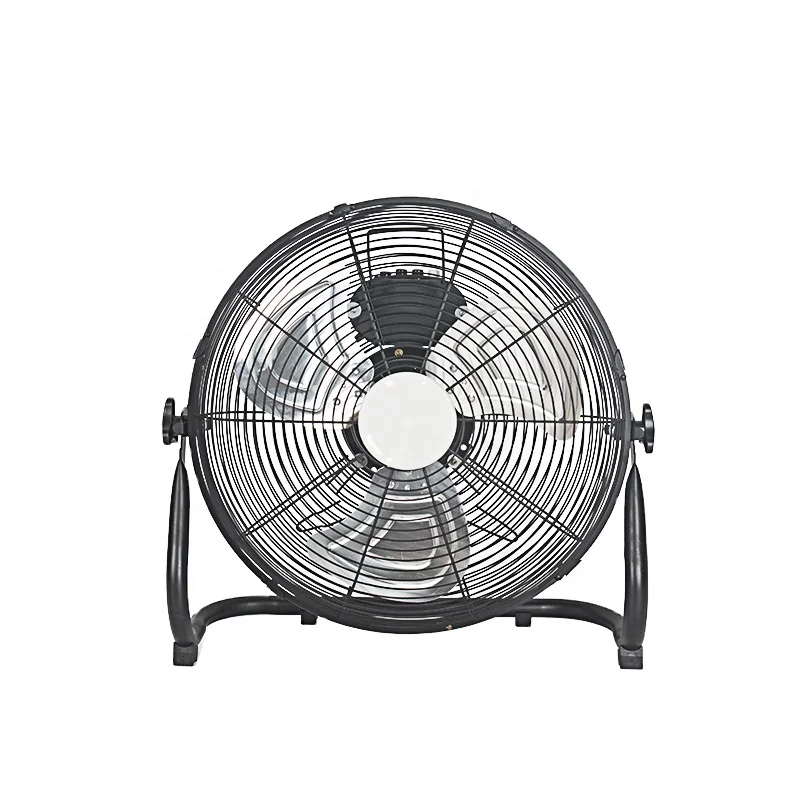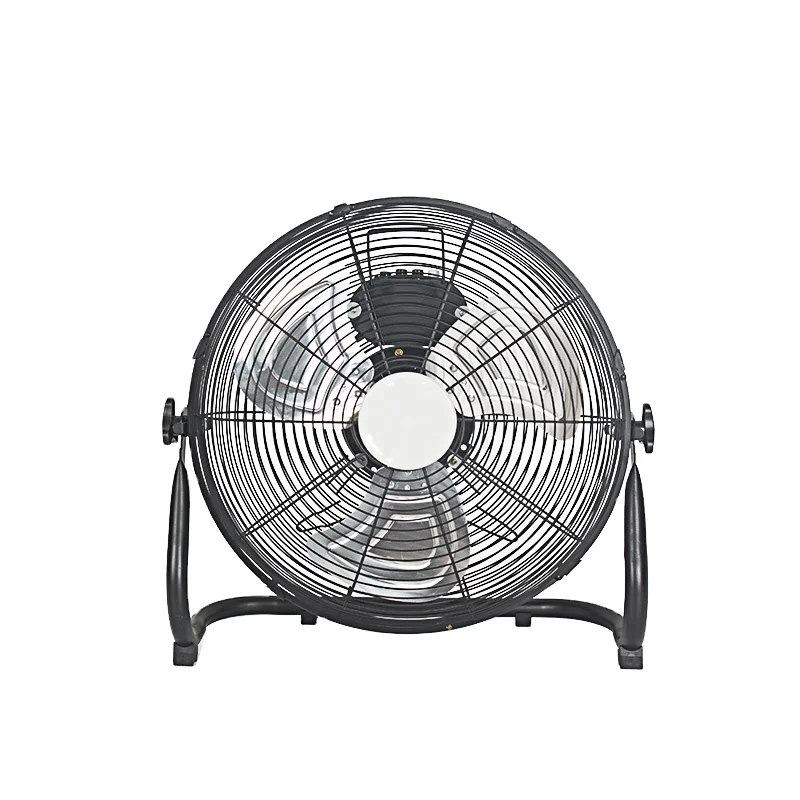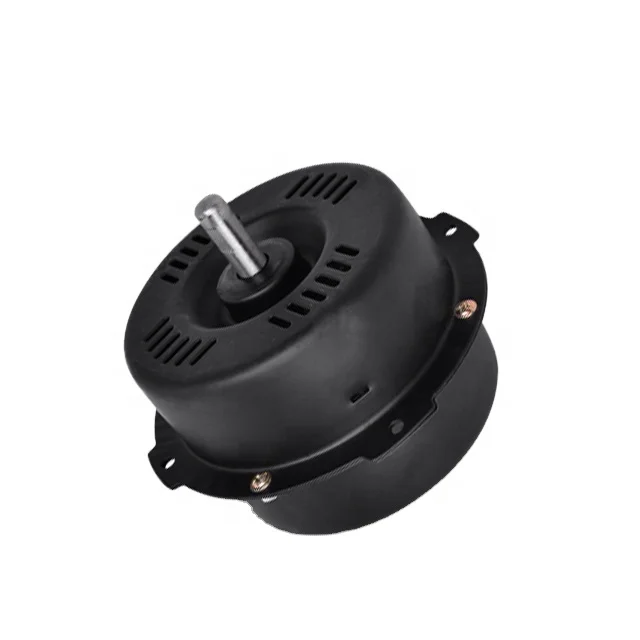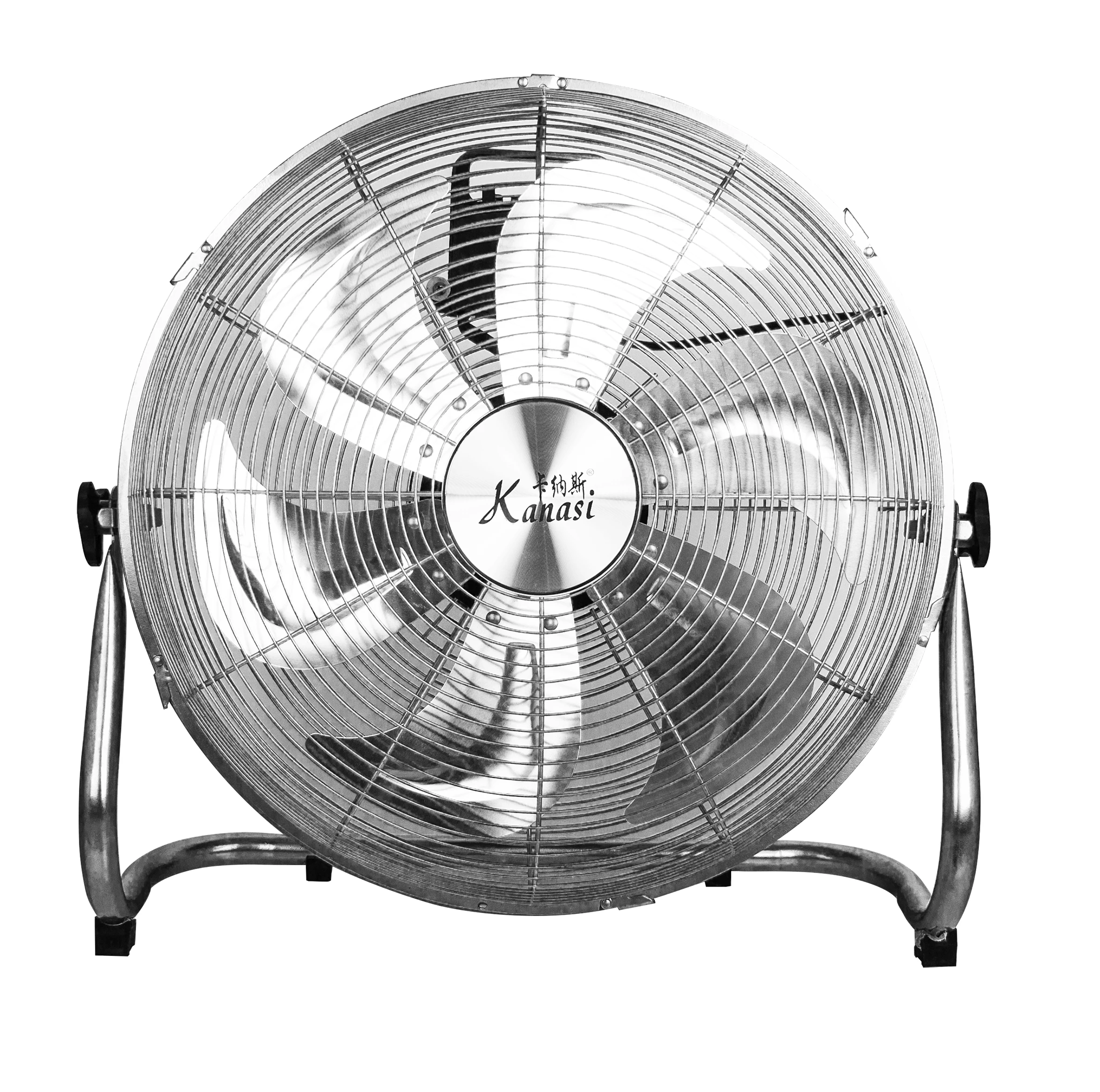Floor Fan is a practical, freestanding cooling appliance designed to sit directly on the floor, delivering targeted airflow to cool indoor spaces efficiently. Unlike Wall Fans that require mounting or Ceiling Fans fixed to overhead surfaces, a Floor Fan offers unmatched flexibility—its portable design lets you place it anywhere there’s floor space, from living rooms and bedrooms to home offices, garages, and small commercial areas like convenience stores or workshops. As a staple in both residential and light commercial settings, Floor Fan focuses on circulating air to create a refreshing wind - chill effect, making it ideal for days when the temperature rises but full - size air conditioning isn’t necessary or too costly to run.
The core function of a Floor Fan is to move large volumes of air across a room, which speeds up the evaporation of sweat from the skin, reducing the perceived temperature and creating an immediate sense of coolness. Unlike Mist Fans that rely on water for evaporative cooling or Exhaust Fans that remove stale air, Floor Fan works by recycling and circulating existing indoor air—this makes it simple to use (no water refills or ductwork needed) and suitable for any enclosed or semi - enclosed space. Most Floor Fan models come with adjustable speed settings, oscillation features, and tiltable fan heads, allowing users to customize airflow direction and intensity to match their comfort needs, whether they’re relaxing on a couch, working at a desk, or cooking in a kitchen.
In today’s market, Floor Fan remains a popular choice due to its affordability, ease of use, and reliable performance. For homeowners, a Floor Fan is a cost - effective backup to air conditioning—using it alongside AC can help distribute cool air more evenly, reducing the AC’s workload and lowering energy bills. For renters or those in small apartments, Floor Fan is a temporary cooling solution that requires no installation (just plug it in and use it) and can be taken along when moving. In commercial spaces, such as small retail stores or workshops, Floor Fan provides quick relief for employees and customers without the expense of installing permanent cooling systems. With a range of sizes—from compact 10 - inch models for personal use to large 20 - inch models for spacious rooms—Floor Fan caters to every cooling need, from targeted personal comfort to whole - room air circulation.
This classification page offers a comprehensive look at Floor Fan products, breaking down their key advantages, expert craftsmanship, and essential features to help users make informed choices. Whether you’re searching for a quiet Floor Fan for your bedroom, a powerful model for your garage, or a compact one for your dorm room, this page explains why Floor Fan is a versatile cooling staple, how it outperforms other portable fans in certain scenarios, and what manufacturing details ensure its durability, safety, and long - term functionality.
Advantage Points
Unmatched Portability and Flexible Placement: The biggest advantage of a Floor Fan is its portability—most models are lightweight (ranging from 3 to 8 pounds) with a compact, freestanding design that lets you move them effortlessly between rooms. Unlike Stand Fans that may have bulkier bases or Wall Fans that need mounting, a Floor Fan can be lifted, carried, or slid across the floor to any spot with a power outlet. For example, you can use it in the living room during the day to cool the family while watching TV, then move it to the bedroom at night for comfortable sleep. Its ability to fit in tight spaces—like between a couch and a coffee table or in a corner of a home office—also makes it ideal for rooms where space is limited. This flexibility means you’re not restricted to cooling one area; you can direct airflow exactly where it’s needed most.
Adjustable Airflow for Personalized Comfort: Floor Fan is designed with user customization in mind, featuring multiple settings to tailor airflow to individual preferences. Nearly all Floor Fan models include 3 to 5 speed settings: low speed delivers a gentle breeze (perfect for sleeping or mild days), medium speed provides balanced airflow for everyday use, and high speed produces a powerful gust to cool large rooms or hot spaces like garages. Most models also have an oscillation function— the fan head swings horizontally (usually 90 to 120 degrees) to distribute air evenly across the room, instead of focusing on one spot. Additionally, many Floor Fans have tiltable fan heads (up to 45 degrees up or down), allowing you to direct airflow towards the floor (to cool your feet while sitting) or upwards (to circulate warm air in winter, making it a year - round appliance).
Energy Efficiency and Low Operating Costs: Floor Fan is extremely energy - efficient compared to air conditioners and even some other cooling appliances. A typical Floor Fan uses between 25 to 75 watts of electricity—less than 10% of the energy consumed by a window air conditioner (which uses 500 to 1,500 watts) and a fraction of what a central AC system requires. Running a Floor Fan for 8 hours a day costs just 1 to 3 cents in electricity (based on average U.S. energy rates), making it an affordable option for long - term use. Unlike Mist Fans that need water refills or Exhaust Fans that may require duct maintenance, Floor Fan has no ongoing costs beyond electricity—this makes it a budget - friendly choice for anyone looking to stay cool without increasing their utility bills.
Easy to Use and Maintain: Floor Fan is one of the simplest cooling appliances to operate—no complex setup, installation, or instructions are needed. Just unpack the fan, place it on a flat floor, plug it into a standard power outlet, and use the control panel (or remote, in advanced models) to adjust speed, oscillation, or power. Maintenance is equally straightforward: most Floor Fans have removable front grilles that can be taken off with a few screws or clips, allowing you to clean the fan blades with a damp cloth or brush to remove dust buildup (which can reduce airflow if left unchecked). Unlike air conditioners that need filter changes or duct cleaning, Floor Fan requires only monthly dusting to keep it running at peak performance. This ease of use and low maintenance make it ideal for users of all ages, from seniors to college students.
Suitable for Year - Round Use: While Floor Fan is primarily associated with summer cooling, it’s a versatile appliance that can be used year - round. In winter, you can use a Floor Fan to circulate warm air that rises to the ceiling—tilt the fan head upwards, set it to low speed, and it will push warm air down into the living space, reducing the need to crank up the heater. This helps distribute heat more evenly throughout the room, keeping you comfortable while lowering heating costs. In spring and fall, when temperatures are mild but rooms can feel stuffy, a Floor Fan provides gentle air circulation to reduce stagnation and keep the air feeling fresh. Unlike seasonal appliances that get stored away for months, Floor Fan remains useful throughout the year, maximizing its value.
Quiet Operation for Undisturbed Use: Modern Floor Fan models are engineered for quiet performance, addressing the common complaint of loud, distracting fans. Manufacturers use noise - reduction technologies like aerodynamically designed fan blades (which minimize air turbulence, a major source of noise), precision - balanced motors (which reduce vibration), and insulated motor housings (which absorb sound). As a result, most residential Floor Fans produce between 30 to 50 decibels—equivalent to the sound of a quiet conversation or a soft radio playing in the background. This quiet operation makes Floor Fan suitable for noise - sensitive spaces like bedrooms (where it won’t disrupt sleep), home offices (where it won’t interfere with calls or work), and nurseries (where it won’t wake babies). Even powerful, large - size Floor Fans for garages or workshops are designed to keep noise levels low enough to avoid overwhelming the space.
Craftsmanship Selling Points
High - Performance Motors for Strong, Consistent Airflow: The motor is the heart of a Floor Fan, and top - tier models feature high - quality motors built for power, efficiency, and longevity. These motors use copper windings (instead of cheaper aluminum) for superior electrical conductivity—copper reduces energy loss, generates less heat, and withstands wear and tear better than aluminum, extending the motor’s lifespan to 8 to 12 years with regular use. Many Floor Fan motors also include permanent split capacitor (PSC) technology, which ensures smooth startup (no jerky movements) and consistent performance across all speed settings, even when the fan is running for hours. To prevent overheating, motor housings are made from heat - resistant materials like aluminum alloy or reinforced plastic with vented designs that allow air to circulate around the motor, keeping temperatures low even during continuous operation (e.g., running all night in a bedroom).
Aerodynamic Fan Blades for Efficient Air Circulation: The design of a Floor Fan’s blades directly impacts its airflow efficiency and noise level, and premium models feature aerodynamically optimized blades. These blades are precision - shaped with a curved “airfoil” design that minimizes air resistance while maximizing air displacement—this means the fan can move more air (measured in cubic feet per minute, CFM) using less energy. Most Floor Fans have 3 to 5 blades: 3 - blade models typically deliver stronger airflow (ideal for large rooms) with slightly more noise, while 5 - blade models offer quieter operation with gentler, more consistent airflow (perfect for bedrooms). Blades are made from high - strength materials like ABS plastic or reinforced polypropylene, which are resistant to warping, cracking, and impact—even if the fan is accidentally bumped, the blades won’t break or lose their shape. Some models also have blade coatings that repel dust, reducing the need for frequent cleaning.
Sturdy, Stable Bases to Prevent Tipping: Safety is a key focus in Floor Fan craftsmanship, and manufacturers design robust bases to keep the fan stable during use. Most bases are made from weighted materials like heavy - duty plastic or metal plates that lower the fan’s center of gravity, preventing it from tipping over if bumped by children, pets, or passersby. The base shape also plays a role—wide, circular or rectangular bases provide more contact with the floor, increasing stability compared to narrow designs. Many bases include non - slip rubber feet that grip the floor tightly, even on smooth surfaces like tile or hardwood, to prevent the fan from sliding when oscillation is on or during high - speed operation. For taller Floor Fan models, the connection between the base and the fan head is reinforced with metal brackets to ensure the structure stays rigid, further reducing the risk of tipping.
Durable Grilles and Outer Casings for Longevity: Floor Fan grilles and outer casings are built to withstand daily use and protect the internal components (like the motor and blades) from dust, debris, and damage. Front and rear grilles are made from metal (usually steel or aluminum) or thick, impact - resistant plastic—metal grilles are more durable and less likely to bend, while plastic grilles are lightweight and rust - proof. Grilles are designed with small, evenly spaced openings to prevent fingers (especially those of children) or small objects from reaching the moving blades, enhancing safety. Outer casings (which house the motor and controls) are made from high - grade plastic or powder - coated metal that resists scratches, fading, and discoloration—even if the fan is moved frequently or exposed to sunlight (e.g., near a window), the casing will maintain its appearance. Some models also have waterproof casings (with IP44 ratings) for use in damp areas like basements or covered patios.
User - Friendly Controls with Durable Components: Floor Fan controls are engineered for ease of use and long - term reliability. Basic models feature intuitive knobs or buttons on the fan body, labeled clearly for “Speed” (Low/Medium/High), “Oscillation” (On/Off), and “Power” (On/Off). Buttons are made from soft - touch, wear - resistant plastic that remains responsive even after thousands of presses, while knobs have textured surfaces for a secure grip (even with wet hands). Advanced Floor Fan models include remote controls, which let users adjust settings from across the room (e.g., from the bed or couch). These remotes are compact, ergonomic, and use long - lasting batteries—some even have backlit buttons for use in dark rooms. Control panels are sealed to prevent dust and spills from damaging the internal electrical components, ensuring the fan continues to work properly even in dusty garages or kitchens.
Compliance with Strict Safety and Quality Standards: All reputable Floor Fan products meet rigorous international safety and quality standards to ensure user protection and performance. Key certifications include UL (Underwriters Laboratories) in the U.S., CE (Conformité Européenne) in Europe, and CCC (China Compulsory Certification) in China—these standards require testing for electrical safety (e.g., protection against electric shocks, short circuits, and fire hazards), mechanical safety (e.g., secure blades, stable bases), and performance (e.g., airflow efficiency, noise levels). For example, Floor Fans must have flame - retardant power cords and plugs that fit securely into outlets, and motors must include overheat protection devices that shut off the fan if temperatures get too high. Additionally, many Floor Fans meet ENERGY STAR® standards, meaning they are more energy - efficient than non - certified models, helping users save on electricity bills. These certifications guarantee that the Floor Fan is safe, reliable, and built to last.





